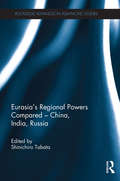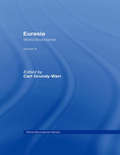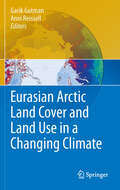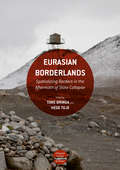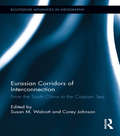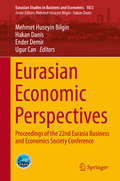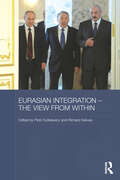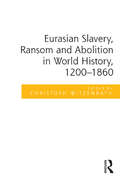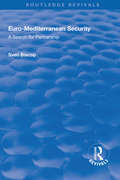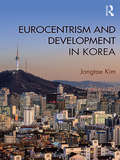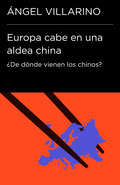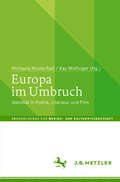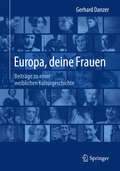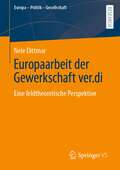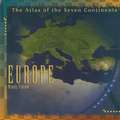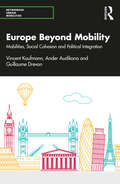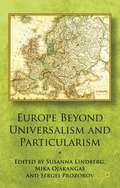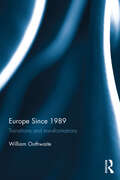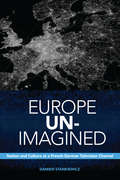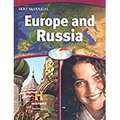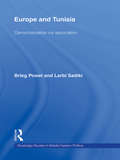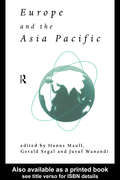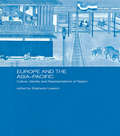- Table View
- List View
Eurasia's Regional Powers Compared - China, India, Russia (Routledge Advances in Asia-Pacific Studies)
by Shinichiro TabataTaking a long view, and a wide perspective, this book by Japan's leading scholars on Asia and Eurasia provides a comprehensive and systematic comparison of the three greatest powers in the region and assesses how far the recent growth trajectories of these countries are sustainable in the long run. The book demonstrates the huge impact on the region of these countries. It examines the population, resource and economic basis for the countries' rise, considers political, social and cultural factors, and sets recent developments in a long historical context. Throughout, the different development paths of the three countries are compared and contrasted, and the new models for the future of the world order which they represent are analysed.
Eurasia: World Boundaries Volume 3 (World Boundaries Series #Vol. 3)
by Carl Grundy-WarrEurasia offers a wide-ranging and original interpretation of territory, boundaries and borderlands in Europe, Asia and the Far East. This forms part of a unique series of books focussing on world boundaries which embrace the theory and practice of boundary delimitation and management, boundary disputes and conflict resolution, and territorial change in the new world order.
Eurasian Arctic Land Cover and Land Use in a Changing Climate
by Garik Gutman Anni ReissellThis volume is a compilation of studies on interactions of land-cover/land-use change with climate in a region where the climate warming is most pronounced compared to other areas of the globe. The climate warming in the far North, and in the Arctic region of Northern Eurasia in particular, affects both the landscape and human activities, and hence human dimensions are an important aspect of the topic. Environmental pollution together with climate warming may produce irreversible damages to the current Arctic ecosystems. Regional land-atmosphere feedbacks may have large global importance. Remote sensing is a primary tool in studying vast northern territories where in situ observations are sporadic. State-of-the-art methods of satellite remote sensing combined with GIS and models are used to tackle science questions and provide an outlook of current land-cover changes and potential scenarios for the future. Audience: The book is a truly international effort involving U.S. and European scientists. It is directed at the broad science community including graduate students, academics and other professionals in this field.
Eurasian Borderlands: Spatializing Borders in the Aftermath of State Collapse (Approaches to Social Inequality and Difference)
by Tone Bringa and Hege TojeThis book examines changing and emerging state and state-like borders in the post-Soviet space in the decades following state collapse. This book argues border-making is not only about states’ physical marking of territory and claims to sovereignty but also about people’s spatial practices over time. In order to illustrate how borders come about and are maintained, this book looks at border communities at internal, open administrative borders and borders in the making, as well as physically demarcated international state borders. This book also pays attention to both the spatial and temporal aspects of borders and the interplay between boundaries and borders over time and thus identifies some of the processes at play as space is territorialized in Eurasia in the aftermath of state collapse.
Eurasian Corridors of Interconnection: From the South China to the Caspian Sea (Routledge Advances in Geography #10)
by Corey Johnson Susan M. WalcottConnectivity, as well as conflict, characterizes Eurasia. This edited volume explores dynamic geopolitical and geo-economic links reconfiguring spaces from the eastern edge of Europe through the western edge of Asia, seeking explanation beyond description. The ancient Silk Road tied together space, much as pipelines, railroads, telecommunications infrastructure, and similar cultural and constructed links ease the mobility of people and products in modern Eurasia. This book considers Eurasia along an interlinked corridor, with chapters illustrating the connections as a discussion foundation focusing on the shared interactions of a set of nation states through time and across space, generating more positive considerations of the resurgently important region of Eurasia. China’s interests fall into three chapters: the southeastern border with Vietnam, the southwestern Himalayan edge, and the western Muslim regions. Russia’s recovery relates events to a larger landmass context and focuses on the importance of historic mobility. A geo-history of the Caspian considers this petroleum-rich area as a zone of cultural and economic interconnection. The final focus on Central Asia treats the traditional heart of “Eurasia”. The concluding chapter pulls together strands linking subregions for a new concept of “Eurasia” as an area linked by vital interests and overlapping histories.
Eurasian Economic Perspectives: Proceedings of the 22nd Eurasia Business and Economics Society Conference (Eurasian Studies in Business and Economics #10/2)
by Mehmet Huseyin Bilgin Hakan Danis Ender Demir Ugur CanThis volume of Eurasian Studies in Business and Economics includes selected papers from the 22nd Eurasia Business and Economics Society (EBES) Conference in Rome. It gathers scholarly contributions on the latest applied economics research from developing countries such as Croatia, Poland, the Baltic and ASEAN countries, which tend to be underrepresented in the current literature. Both the theoretical and empirical papers in this volume cover diverse areas of economic research from various regions. The main focus is on sharing the latest findings on empirical industrial organization, in particular the economics of innovation, regional economic development dynamics, and banking sector reforms in developing countries.
Eurasian Integration - The View from Within (Routledge Contemporary Russia and Eastern Europe Series)
by Richard Sakwa Piotr DutkiewiczAs Eurasia and the adjacent territories become more important to the world, there is increasing interest from international powers, accompanied by attempts to give institutional form to traditional economic and security links within the region. This book includes a range of substantive work from scholars based in the region, offering contrasting perspectives on the process of Eurasian integration and its place in the world. Chapters consider economic, political, social and security developments, with notable studies of the major countries involved in the development of the Eurasian Economic Union. The work also examines the connections between the region and China, greater Asia and the European Union. It outlines the varying dynamics, with populations growing in Central Asia while at best stagnant elsewhere. The book discusses the increasing strategic significance of the region and explores how the new post-Soviet states are growing in national cohesion and political self-confidence. Above all, the book examines the concept of ’Eurasia’, outlining the debates about the concept and how various aspects of the legacy of ‘Eurasianism’ contribute to contemporary plans for integration. The book argues that although regional integration is very much a popular idea in our age, with the potential for economic benefits and increased international influence, in practice contemporary projects for Eurasian integration have been highly ambiguous and contested. Nevertheless, significant steps have been taken towards the creation of the Eurasian Economic Union. The book analyses developments to date, noting the achievements as well as the challenges.
Eurasian Slavery, Ransom and Abolition in World History, 1200-1860
by Christoph WitzenrathRecent research has demonstrated that early modern slavery was much more widespread than the traditional concentration on plantation slavery in the context of European colonial expansion would suggest. Slavery and slave trading, though little researched, were common across wide stretches of Eurasia, and a slave economy played a vital part in the political and cultural contacts between Russia and its Eurasian neighbours. This volume concentrates on captivity, slavery, ransom and abolition in the vicinity of the Eurasian steppe from the early modern period to recent developments and explores their legacy and relevance down to the modern times. The contributions centre on the Russian Empire, while bringing together scholars from various historical traditions of the leading states in this region, including Poland-Lithuania and the Ottoman Empire, and their various successor states. At the centre of attention are transfers, transnational fertilizations and the institutions, rituals and representations facilitating enslavement, exchanges and ransoming. The essays in this collection define and quantify slavery, covering various regions in the steppe and its vicinity and looking at trans-cultural issues and the implications of slavery and ransom for social, economic and political connections across the steppe. In so doing the volume provides both a broad overview of the subject, and a snapshot of the latest research from leading scholars working in this area.
Euro-Mediterranean Security: A Search for Partnership (Routledge Revivals Ser.)
by Sven BiscopThis title was first published in 2003. This work provides a clearer understanding of the EU's approach towards security in the Mediterranean. After examining the EU's interests and the potential threats to security in the region, it analyzes EU security policy towards the region as a whole, through the Euro-Mediterranean Partnership, and towards all disputes and conflicts in the area. It recommends opening up the European Security and Defence Policy to Mediterranean participation, in order to establish a deep and equitable security partnership between both shores. The book argues that this way the EU could implement its innovative comprehensive and co-operative approach to security. Rather than focusing on the military aspect alone, this approach takes into account all dimensions of security (political, socio-economic, cultural and ecological) and is based on partnership rather than confrontation. It therefore contrasts quite sharply with the policies advocated in the US National Security Strategy.
Eurocentrism and Development in Korea (Routledge Studies in Emerging Societies)
by Jongtae KimUnder the global hegemony of the West, societies have interpreted the world and defined their identities through the frameworks of Eurocentric discourses. Since the mid-twentieth century, Eurocentrism has tended to be associated with economic developmentalism. The discourse of seonjinguk (developed country) has been a dominant Eurocentric developmental discourse in Korea. However, in what historical contexts have the Koreans set seonjinguk as their national goal and yardstick to judge nations? What roles have been played by the concept of seonjinguk in Korea? What discursive frameworks did the Koreans use for their national identities and worldviews before the developmental era? Eurocentrism and Development in Korea is the first scholarly approach to those questions. Through a chronological analysis of Korea’s dominant discourses from the late nineteenth century to the present, Kim demonstrates the historical nature of developmentalism and seonjinguk discourse for Korea’s developmental era, and traces their genealogy to gaehwa (enlightenment) and munmyeong (civilization) discourses from a sociological historical perspective. Providing essential knowledge about Korea’s history of Eurocentrism, developmentalism and national change, this enlightening monograph will appeal to undergraduate and postgraduate students, as well as postdoctoral researchers, interested in fields such as Korean Studies, Development Studies and Global Sociology.
Europa cabe en una aldea china: ¿De dónde vienen los chinos? (Colección Endebate #Volumen)
by Ángel VillarinoLa historia de los orígenes de los chinos que viven en España. Alrededor del setenta por ciento de los chinos que viven en España proceden de un mismo condado: Quingtian, una región montañosa situada en una de las provincias orientales al sur de Shanghái. Desde hace unas décadas este condado se ha convertido en uno de los lugares más prósperos de China gracias a las inversiones de sus emigrantes, que envían dinero desde España o lo traen consigo al regresar a su tierra natal. Ángel Villarino habla con las gentes de Quingtian y nos cuenta las historias familiares de los emigrantes chinos que encontramos detrás de los mostradores de bazares, peluquerías, restaurantes y otros negocios que han proliferado a lo largo y ancho de la geografía española.
Europa im Umbruch: Identität in Politik, Literatur und Film (Abhandlungen zur Medien- und Kulturwissenschaft)
by Michaela Nicole Raß Kay WolfingerDieser Band zum Begriff „Europa“ beruht auf einer Tagung, die im Winter 2018 in der Carl Friedrich von Siemens Stiftung in München stattfand. Europa in seiner Vielschichtigkeit, in seinem Umbruchcharakter und seiner Faszinationskraft ist von ungebrochener Aktualität. Gleichzeitig ist die europäische Identität durch aktuelle Herausforderungen wie etwa Populismus und Erstarken des Nationalismus gefährdet. Die Beiträge der Tagung gehen der Frage nach, inwieweit die Gegenwartsliteratur und auch aktuelle Filme auf diese Umbrüche reagieren und inwieweit die Rede von einer Krise Europas oder der europäischen Integration in den Bereichen Literatur und Film wahrnehmbar ist. Im historischen Rückblick lässt sich beobachten, dass sich gerade in Destabilisierungs-, Umbruchs- und Krisenmomenten die Intensität des Europa-Diskurses verstärkt und dieser an Komplexität gewonnen hat.
Europa, deine Frauen
by Gerhard DanzerFrauen sind in den letzten Jahrhunderten - ganz bevorzugt in den letzten Jahrzehnten - kulturgeschichtlich viel intensiver und origineller tätig gewesen, als dies gemeinhin wahrgenommen wird. Was genau die kulturhistorischen Dimensionen des ,,Frau-Seins" sind, wird vom Autor differenziert betrachtet und dargestellt. Die Kulturgeschichte würde ohne den Anteil, den diese Frauen daran hatten, ganz anders aussehen. Der weibliche Einfluss ist unverkennbar im Wachsen begriffen und sein Anteil an kulturgeschichtlicher Entwicklung darf nicht unterschätzt werden. Madame de Sévigné - Madame du Châtelet - Johanna Schopenhauer - Rahel Varnhagen - Louise Labé - Elisabeth Barrett-Browning - George Eliot - Marie von Ebner-Eschenbach - Gabriele Münter -Therese Giehse - Melina Mercouri - Pina Bausch - Ellen Key - Maria Montessori - Karen Horney - Astrid Lindgren - Bertha von Suttner - Beatrice Webb- Rosa Luxemburg - Franca Magniani - Margarete Susman - Hannah Arendt - Simone de Beauvoir - Agnes Heller
Europaarbeit der Gewerkschaft ver.di: Eine feldtheoretische Perspektive (Europa – Politik – Gesellschaft)
by Nele DittmarIn der sozialwissenschaftlichen Debatte wird oft ein pessimistisches Bild der Bedingungen und Perspektiven europäischen gewerkschaftlichen Handelns gezeichnet. Selten wurde aber bisher in eine nationale Gewerkschaft hineingeschaut und gefragt, ob und inwiefern die innergewerkschaftlichen (Macht-)Verhältnisse ihre europabezogene Arbeit beeinflussen. Diese Arbeit setzt dort an und lenkt auf der Suche nach den Möglichkeiten und Grenzen gewerkschaftlicher Interessenvertretung in Europa den Blick in eine nationale Gewerkschaft hinein. Am Beispiel der Vereinten Dienstleistungsgewerkschaft ver.di bringt dies einerseits europabezogene Praktiken zum Vorschein, die aus einer Makroperspektive verdeckt bleiben. Andererseits werden neue Erkenntnisse zu Hindernissen gewerkschaftlicher Europaarbeit gewonnen, die in den innerorganisatorischen Strukturen und Machtrelationen selbst begründet sind. Für den Blick in die Gewerkschaft wird in dieser Arbeit eine feldtheoretische Perspektive eingenommen. Damit wird ihre „Europaarbeit“ durch das Zusammenspiel der Position der Gewerkschaft in anderen Feldern (wie dem der deutschen und der europäischen Arbeitsbeziehungen) und den Kräfteverhältnissen innerhalb der Gewerkschaft selbst erklärt.
Europe (Atlas of the Seven Continents)
by Wendy VierowEurope, the second smallest continent on Earth, has 43 countries. Some geographers consider Europe part of a landmass that includes Asia, called Eurasia. Actually, it is a large peninsula, or mass of land that is surrounded on three sides by water. Europe s climate ranges from frozen tundra to warm Mediterranean. The first great civilization in Europe reached its height in Greece about 2,500 years ago. Since then, empires have risen and fallen in Europe. Today, many different ethnic groups call Europe home.
Europe (In Theory)
by Roberto M. DainottoEurope (in Theory) is an innovative analysis of eighteenth- and nineteenth-century ideas about Europe that continue to inform thinking about culture, politics, and identity today. Drawing on insights from subaltern and postcolonial studies, Roberto M. Dainotto deconstructs imperialism not from the so-called periphery but from within Europe itself. He proposes a genealogy of Eurocentrism that accounts for the way modern theories of Europe have marginalized the continent's own southern region, portraying countries including Greece, Italy, Spain, and Portugal as irrational, corrupt, and clan-based in comparison to the rational, civic-minded nations of northern Europe. Dainotto argues that beginning with Montesquieu's The Spirit of Laws (1748), Europe not only defined itself against an "Oriental" other but also against elements within its own borders: its South. He locates the roots of Eurocentrism in this disavowal; internalizing the other made it possible to understand and explain Europe without reference to anything beyond its boundaries. Dainotto synthesizes a vast array of literary, philosophical, and historical works by authors from different parts of Europe. He scrutinizes theories that came to dominate thinking about the continent, including Montesquieu's invention of Europe's north-south divide, Hegel's "two Europes," and Madame de Stal's idea of opposing European literatures: a modern one from the North, and a pre-modern one from the South. At the same time, Dainotto brings to light counter-narratives written from Europe's margins, such as the Spanish Jesuit Juan Andrs's suggestion that the origins of modern European culture were eastern rather than northern and the Italian Orientalist Michele Amari's assertion that the South was the cradle of a social democracy brought to Europe via Islam.
Europe Beyond Mobility: Mobilities, Social Cohesion and Political Integration (Networked Urban Mobilities Series)
by Vincent Kaufmann Ander Audikana Guillaume DrevonMobility, which has represented a critical scientific category and political driver, is currently under strong public scrutiny: has mobility lost its potential for social cohesion and political integration? Europe Beyond Mobility: Mobilities, Social Cohesion and Political Integration assesses this question by focusing on the European integration process, conceptualized as a political project for the promotion of different flows of mobility. Mobility has been a fundamental tool for territorial strength and political integration among European countries. Based on a realistic understanding of the potentials and limits of mobility, this book pleads for a "resonant mobility" in the interest of a renovated European integration process. It examines how, in opposition to those advocating for national borders and mobility restrictions, the EU needs to explore new regulatory models which limit mobility’s adverse social, economic, and environmental impacts and make accessible the benefits of alternative flow models. It also provides an analytical framework for the study of current trends of mobility limitation, migration restriction and re-bordering, and offers a complementary and innovative framework for the study of globalization. Europe Beyond Mobility will be of interest to academics and students as well as policy makers and practitioners internationally in the fields of mobility, migration and border studies.
Europe Beyond Universalism And Particularism
by Susanna Lindberg Mika Ojakangas Sergei ProzorovResulting from an interdisciplinary dialogue between philosophy, political science and International Relations about Europe as a political community this volume rethinks the European political project beyond the rigid opposition between universalism and particularism approaching Europe as a space of the exposure of differences to each other.
Europe Since 1989: Transitions and Transformations
by William OuthwaiteEurope Since 1989 charts the development of Europe east and west since the 1989 revolutions. It analyses the emergent European society, the development of a European public sphere, and civil society. Most books on Europe are heavily biased to the West and Europe Since 1989 takes the opposite approach. It argues that the transformation of the postcommunist world has implications for the whole of Europe and explores the interplay between long-term fundamental tendencies and chance events and the possible futures which confront contemporary Europe. With close attention to political, economic and other social transformations, and an appendix which gives special attention to European macro regions (Nordic/Baltic Europe, Mediterranean Europe), it offers a sociology of Europe with a strong interdisciplinary emphasis.
Europe Un-Imagined: Nation and Culture at a French-German Television Channel
by Damien StankiewiczEurope Un-Imagined examines one of the world’s first and only trans nationally produced television channels, Association relative à la télévision européenne (ARTE). ARTE calls itself the "European culture channel" and was launched in 1991 with a French-German intergovernmental mandate to produce television and other media that promoted pan-European community and culture. Damien Stankiewicz’s ground-breaking ethnographic study of the various contexts of media production work at ARTE (the newsroom, the editing studio, the screening room), reveals how ideas about French, German, and European culture coalesce and circulate at the channel. He argues that the reproduction of nationalism often goes unacknowledged and unremarked upon, and questions whether something like a European "imagination" can be produced. Stankiewicz describes the challenges that ARTE staff face, including rapidly changing media technologies and audiences, unreflective national stereotyping, and unwieldy bureaucratic infrastructure, which ultimately limit the channel’s abilities to cultivate a transnational, "European" public. Europe Un-Imagined challenges its readers to find new ways of thinking about how people belong in the world beyond the problematic logics of national categorization.
Europe and Russia
by Christopher L. SalterThe text covers the history and geography of Europe and Russia. Contains Maps and Resources.
Europe and Tunisia: Democratization via Association (Routledge Studies in Middle Eastern Politics)
by Larbi Sadiki Brieg PowelThis book is concerned with EU democracy promotion inside Tunisia, the first Arab signatory of an Association Agreement with the EU. Focusing on the content, context, mechanisms, and outcomes of democratization via association, the authors examine whether Tunisia’s specific mode of democratization works in tandem with EU democracy promotion objectives, and the extent to which both adapt association in a way that neither sabotages EU democracy promotion nor undermines Tunisia’s specificity. Drawing on Arabic, English and French sources, the book deploys a variety of methods and disciplinary approaches - discourse analysis, interviews, democratization theory, foreign policy analysis, security studies, political history, nationalism and identity – and takes an interpretivist perspective, conceiving of political processes as fluid and tentative. The first comprehensive study of the effects of the Union’s Mediterranean democracy promotion strategy on a single recipient state, this book will be relevant to students of Middle East politics, European foreign policy, Euro-Mediterranean studies, democratization theory, and Euro-Arab relations, this book will also be of great interest to researchers, academics and policy-makers.
Europe and the Asia-Pacific
by Gerald Segal Hanns Maull Jusuf WanandiEurope and the Asia-Pacific is the most wide-ranging and accessible book currently available on the increasingly important relationship between these two regions. Compiled by leading experts, it covers the historical background, contemporary political setting and the vitally important economic aspects of this relationship. Moving on to deal with security considerations and policy decisions it provides valuable insights into the developing partnership between Europe and the Asia-Pacific. Rigorous and up-to-date, it is born out of the work of the Council for Asia-Europe cooperation (CAEC), a body of think tanks that supports the Asia-Europe Summit Meeting (ASEM) process.
Europe and the Asia-Pacific: Culture, Identity and Representations of Region
by Stephanie LawsonThe many points of contact and conflict about culture and identity that exist between Europe and the Asia Pacific are highlighted in this book. This work surveys a variety of issues relating to culture, identity and representation from an interdisciplinary perspective, with contributions from sociology, economics, history, politics, international relations, security studies, museum studies, translation studies and literary and cultural studies. Each brings a different perspective to bear on questions of culture and identity in the contemporary period, and how these relate to the politics of representation.
